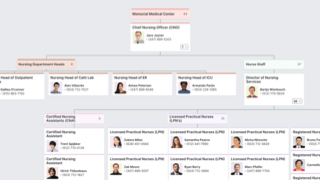Nursing Organizational Chart
Review our org chart for nurses to better understand who reports to who and the essential roles within a nursing staff. Check out our sample nursing organizational chart to see one way nursing staff can be organized.
Build Your Org ChartReady to get started?
Download the Nursing org chart template above, add your own employee data, and Import into Pingboard. Note: you’ll need a Pingboard account first. Sign up for a free trial.
Pro Tip You can build your org chart automatically. Instead of filling out a spreadsheet, you can connect your HR system to Pingboard to automatically sync employee data. Your org chart will get updated automatically every time a change happens. We integrate with ADP, Azure, BambooHR, Google Apps, Namely, Okta, and more.
Common Roles Found in Nursing Organizational Structures
Chief Nursing Officer (CNO)
At the top of nursing hierarchy charts, hospitals typically have a Chief Nursing Officer (CNO), sometimes called a Chief Nurse Executive. The CNO usually reports to the hospital’s CEO and is responsible for the following tasks
- Managing nursing budgets
- Determining compensation packages
- Advising senior nurse management on best practices
- Determining the recruitment, hiring, and retention processes for nursing staff
- Representing the nursing department at board meetings
- Communicating new nursing procedures or policies being implemented across the hospital
Director of Nursing Services
Under the CNO hospitals typically have a Director of Nursing Services (DON) and Nursing Department Heads. DONs are registered nurses. Their responsibilities usually include
- Establishing hiring and training standards for nurses
- Performing rounds to observe care and interview staff, residents, families, or other interested parties to ensure quality of care is up to the hospital’s standard of care
- Setting overarching goals for nursing department and staff
- Maintaining department budgets
- Monitoring incidents and complaints to identify those defined as unusual occurrences by state policy, and to report them to the Administrator/Executive Director
- Determining and overseeing nursing employee conduct standards
The heads of nursing departments are responsible for the management and care of patients in their units. Here’s a list of common department head titles and links to their job descriptions:
- Nursing Head of Cardiology
- Nursing Head of Cath Lab
- Nursing Head of ER
- Nursing Head of ICU
- Nursing Head of Labor and Delivery
- Nursing Head of Outpatient Services
Certified Nursing Assistants
Certified Nursing Assistants (CNAs) are the first touchpoints most patients have with hospitals. A CNA’s main goal is to meet the basic health needs of their patients. In addition to helping patients with personal hygiene needs (replacing bedpans, assisting with baths, backrubs, shaves, etc.), CNAs are responsible for:
- Assisting with lifting, positioning, and transporting patients into and out of beds, chairs, bathtubs, wheelchairs, etc.
- Routinely reviewing care plans to be advised of changes in the residents’ care routines
- Maintaining compliance with BMM/Buckner policies and procedures.
- Maintaining compliance with all regulatory requirements, as well as state and federal laws
- Documenting their actions by completing forms, reports, logs, and records
- Communicating clearly and effectively to patients, their family members, guests, and other members of the healthcare team
Licensed Practical Nurses
A Licensed Practical Nurse (LPN) will record patient vitals and administer medications, as well as communicate with patients over the phone and assemble equipment like catheters and oxygen supplies. LPNs must be skilled in balancing care for patients and completing practical daily administrative tasks. In addition, LPNs are responsible for:
- Performing diagnostic tests including but not limited to EKGs, audiograms, tympanograms, spirometry, and visual screenings, and reporting on and documenting these as appropriate
- Monitoring inventory of medical and/or office supplies and equipment, ensuring units and/or rooms are properly stocked and supplies are current and not expired
- Ordering supplies as needed
- Collecting data through observation and communicating information to assist the RN and/or provider in patient assessment and care planning
- Refilling medication following the ARC refill protocols
- Following all hospital policies, including but not limited to, OSHA, HIPAA, compliance, and code of conduct
Charge Nurse
Registered Charge Nurses (CNs) supervise Registered Nurses, Licensed Vocational Nurses, and other non-licensed nursing personnel. Charge nurses combine managerial skills and clinical experience. A charge nurse job is the stepping stone to higher-level positions in nursing management. Here are a few specific tasks that Charge Nurses are responsible for:
- Delegating nursing assignments
- Preparing shift schedules
- Overseeing patient admissions and discharges
- Completing performance evaluations and disciplinary actions for nursing staff in their department
Want more examples? Check out our templates for hospitals.
